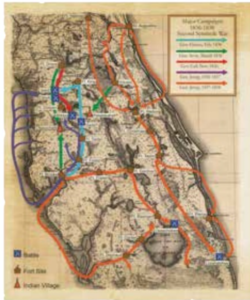The First Seminole War (1816-1819)

Several years after the conclusion of the War of 1812, the U.S. military began excursions into the Spanish owned territory of Florida. General Andrew Jackson ordered his military to invade and destroy the “Negro Fort” on the Apalachicola River in 1816, because it was populated by the Seminole and runaway slaves who he believed needed to be dealt with to make way for American settlers.
This was the catalyst of the Seminole War.
In 1818, Jackson and his military invaded Florida and constructed Fort Gadsden atop the ruins of the “Negro Fort” that was destroyed two years earlier. From Fort Gadsden, Jackson launched the First Seminole War. The Spanish were ill equipped to defend their territory of Florida as Jackson easily took two Spanish fortifications in Pensacola and St. Marks.
No longer able to protect their land, the Spanish agreed to surrender the region to the United States in the Adamas-Onis Treaty of 1819. This seemed to reconcile the matter of Americans’ right to settle the land.
The Second Seminole War (1835-1842)

After years of managing conficts between the American settlers and Native Americans all along the east coast, the United States government passed the Indian Removal Act of 1830 which sought to relocate all Native Americans to newly established Indian Territory west of the Mississippi River.
In Florida this meant the Seminole were once again to be displaced. Tensions rose and fghting began with the Seminole attack on Major Francis Dade and his troops who were in route to Fort King, and the almost simultaneous killing of the Indian Removal Agent, Wiley Thompson, and others at Fort King in December 1835. For seven years, the warfare continued, eventually resulting in the removal of most of the Seminole population to Oklahoma.
It was during this confict that Osceola and Micanopy were captured by the U.S. Army under a false fag of truce. At the end of the war in 1842, a few hundred Seminole were permitted to remain in south Florida.
The Third Seminole War (1855-1858)

Settlers continued to push farther and farther south into the state putting more pressure on the Seminole and making it nearly impossible for them to survive. The U.S. Army destroyed a Seminole plantation west of the Everglades in December 1855.
The Seminole retaliated with an attack near Fort Myers. This set into motion the balance of the Seminole War which consisted mainly of minor raids. Many more Seminole, captured or surrendered, were relocated to Oklahoma.
Those that remained lived deep in the Everglades and the Big Cypress Swamp, land that the white settlers did not want.


